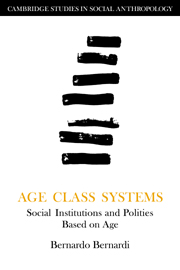Book contents
- Frontmatter
- Contents
- Translator's Preface
- Preface
- 1 Characteristics of age class systems
- 2 The anthropological study of age class systems
- 3 Legitimation and power in age class systems
- 4 The choice of ethnographic models
- 5 The initiation model
- 6 The initiation-transition model
- 7 The generational model
- 8 The residential model
- 9 The regimental model
- 10 The choreographic model
- 11 Women and age class systems
- 12 The ethnemic significance of the age class system
- 13 History and changes in age class systems
- Glossary
- References
- Index
Preface
Published online by Cambridge University Press: 29 September 2009
- Frontmatter
- Contents
- Translator's Preface
- Preface
- 1 Characteristics of age class systems
- 2 The anthropological study of age class systems
- 3 Legitimation and power in age class systems
- 4 The choice of ethnographic models
- 5 The initiation model
- 6 The initiation-transition model
- 7 The generational model
- 8 The residential model
- 9 The regimental model
- 10 The choreographic model
- 11 Women and age class systems
- 12 The ethnemic significance of the age class system
- 13 History and changes in age class systems
- Glossary
- References
- Index
Summary
My goal in these pages is to clarify the nature of age class systems and to identify their basic characteristics. The social and political organization set in motion by such systems is of a peculiar type: Through the classification of coevals into formal social groupings – that is, into age classes – it provides for the promotion of all members of a society along a scale of social gradation. Classes and grades within such systems have an institutional character. Those who become members of the same class are not necessarily coevals in the sense of their physiological age; rather, their grouping is based on the structural value attached to the idea of age, so that the recruits of the same period of time who form a single class are conceived of as if they were of the same age. Clearly, structural age is a species of relative and social age. (A glossary of terminology related to age class systems is found at the end of this book.)
By their institutional character, age classes and grades are distinguished from informal age grades – which are found in all societies as indicative categories (such as infancy, adolescence, etc.) – and from occasional age groups that, for various reasons, may be formed by coevals on the basis of their physiological age or on any other interpretation of the idea of age.
- Type
- Chapter
- Information
- Age Class SystemsSocial Institutions and Polities Based on Age, pp. xiii - xviPublisher: Cambridge University PressPrint publication year: 1985

